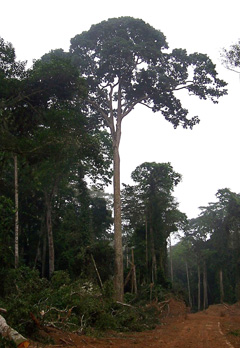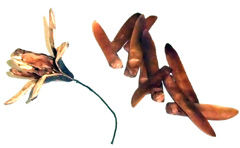 |
|
Public Domain |
 |
| Théo Vansteenkeste wikimedia.org |
Translate this page:
Summary
Entandrophragma cylindricum or Sapele Mahogany is a slow-growing tree with a rounded crown and straight, cylindrical, buttressed bole of up to 200 cm in diameter. It is evergreen or deciduous and can grow up to 60 m in height. It is one of the most important commercial timbers in tropical Africa. Its bark is used in traditional medicine particularly against bronchitis, lung problems, cold, oedema, wounds, and furuncles. It can also be used to protect stored maize from pests like maize weevil (Sitophilus zeamais). The bark yields essential oil. The wood is moderately heavy, moderately hard, and moderately durable. It is commonly used for flooring, panelling, stairs, high class furniture, musical instruments, etc.
Physical Characteristics

 Entandrophragma cylindricum is a deciduous Tree growing to 50 m (164ft) by 30 m (98ft) at a slow rate.
Entandrophragma cylindricum is a deciduous Tree growing to 50 m (164ft) by 30 m (98ft) at a slow rate.
See above for USDA hardiness. It is hardy to UK zone 10. The plant is not self-fertile.
Suitable for: light (sandy), medium (loamy) and heavy (clay) soils and prefers well-drained soil. Suitable pH: mildly acid, neutral and basic (mildly alkaline) soils. It can grow in semi-shade (light woodland) or no shade. It prefers moist soil.
UK Hardiness Map
US Hardiness Map
Synonyms
Entandrophragma lebrunii Staner Entandrophragma rufum A.Chev. Entandrophragma tomentosum A.Chev. ex
Plant Habitats
Edible Uses
References More on Edible Uses
Medicinal Uses
Plants For A Future can not take any responsibility for any adverse effects from the use of plants. Always seek advice from a professional before using a plant medicinally.
Anodyne Skin
The bark is used in traditional medicine. A decoction or maceration is taken to treat bronchitis, lung complaints, colds, oedema and as an anodyne[ 299 ]. The bark pulp is applied externally to furuncles and wounds[ 299 ]. The lactone entandrophragmin has been isolated from the heartwood and bark. It showed high toxicity to tadpoles[ 299 ]. The bark contains tannins and several acyclic triterpenoids, called sapelenins[ 299 ].
References More on Medicinal Uses
The Bookshop: Edible Plant Books
Our Latest books on Perennial Plants For Food Forests and Permaculture Gardens in paperback or digital formats.

Edible Tropical Plants
Food Forest Plants for Hotter Conditions: 250+ Plants For Tropical Food Forests & Permaculture Gardens.
More

Edible Temperate Plants
Plants for Your Food Forest: 500 Plants for Temperate Food Forests & Permaculture Gardens.
More

More Books
PFAF have eight books available in paperback and digital formats. Browse the shop for more information.
Shop Now
Other Uses
Charcoal Essential Fuel Furniture Insecticide Lacquer Repellent Resin Tannin Wood
Other Uses: Bark extracts have been used to protect stored maize from pests[ 299 ]. The extracts have shown inhibitory effects on the reproduction of the maize weevil Sitophilus zeamais[ 299 ]. The tannin present in the bark has been used experimentally to produce tannin-formaldehyde resin, which can be used as lacquer, although the drying time was rather long, 5 - 7 hours[ 299 ]. An essential oil is obtained from the bark. The major constituents are y-cadinene (9 - 23%), a-copaene (7 - 22%) and T-cadinol (18 - 28%)[ 299 ]. The seeds contain about 45% oil. The fatty acid composition of the oil is characterized by the presence of about 50% cis-vaccenic acid, a rare isomer of oleic acid, that can be used in the industrial production of nylon-11[ 299 ]. Other major fatty acids are stearic acid (16%), oleic acid (7%), linoleic acid (5%) and linolenic acid (6%)[ 299 ]. The heartwood is pinkish brown when freshly cut, darkening upon exposure to reddish brown or purplish brown; it is distinctly demarcated from the 4 - 8cm wide band of creamy white to pinkish grey sapwood. The grain is interlocked or wavy; texture fairly fine; there is a a distinct cedar-like smell. The wood is moderately heavy, moderately hard; it is moderately durable, being liable to powder-post beetle, pinhole borer and marine borer attacks, with moderate resistance to termites and fungi, and good resistance to dry wood borers. It seasons normally, with a high risk of distortion; once dry it is moderately stable in service. The wood saws and works easily with both hand and machine tools; it has only slight blunting effects on cutting edges. In planing and moulding operations, a 15 - 20° cutting angle is recommended to avoid picking up of grain. Finishing gives usually good results, with a nice polish. The wood is not liable to splitting in nailing and screwing, with good holding properties. The gluing, staining and polishing properties are good, but the steam bending properties are poor. The wood is suitable for the production of both sliced and rotary veneer; steaming for 48 - 72 hours at 85°C gives good results. The wood is highly valued for flooring, interior joinery, interior trim, panelling, stairs, high class furniture, cabinet work, musical instruments, carvings, ship building, veneer and plywood. It is suitable for construction, vehicle bodies, toys, novelties, boxes, crates and turnery[ 299 , 848 ]. The bole is traditionally used for dug-out canoes[ 299 ]. Wood that can not be utilized as timber is used as firewood and for charcoal production[ 299 ].
Special Uses
References More on Other Uses
Cultivation details
A tree of low to medium elevations in the moist tropics[ 299 ]. It favours areas where the annual rainfall is around 1,750 mm, there is a dry period of 2 - 4 months and a mean annual temperature of 24 - 26°c[ 299 ]. Prefers well-drained soils, being more tolerant of dry forest than any other member of the genus[ 299 ]. It is generally recognized as a non-pioneering tree that demands plenty of light, although a study in DR Congo indicated it as being exceptionally shade-tolerant[ 299 ]. Seedlings up to 2 years old require light shade, but thereafter they should be gradually exposed to more light. They can survive for several years in the shade without significant growth, but when a gap is created in the forest providing enough light further development into a tree starts[ 299 ]. Natural regeneration is often scarce in natural forest, but logging operations creating gaps may promote regeneration, larger gaps appearing more favourable[ 299 ]. Under natural conditions, seeds germinate abundantly, but mortality of seedlings is high, less than 1% reaching 10 cm stem diameter[ 299 ]. Seedlings grow slowly, at around 20 - 40 cm/year[ 299 ]. Root development takes considerable time[ 299 ]. The mean annual diameter increment for trees in the Central African Republic has been established at 3.9mm, but the variability is large. For trees planted in lines in forest in Cameroon, the average annual height growth during 40 years was 30 - 50cm and average annual diameter growth 4 - 8mm. Trees planted in the open in Cote d'Ivoire reached an average height of 5.4 metres and an average stem diameter of 10cm after 7 years, with a survival rate of 74%[ 299 ]. Trees start flowering when 35 - 45 years old. Fruit production starts when trees have reached bole diameters above 50 cm. This has implications for forest management; minimum felling diameters should be well above 50 cm to allow natural regeneration[ 299 ]. Trees can live for over 500 years[ 299 ]. The trees lose their leaves for 2 - 4 weeks, or gradually change leaves over a period of 8 - 13 weeks[ 299 ]. A dioecious species, both male and female forms need to be grown if fruit and seed are required[ 299 ].
References Carbon Farming Information and Carbon Sequestration Information
Temperature Converter
Type a value in the Celsius field to convert the value to Fahrenheit:
Fahrenheit:
The PFAF Bookshop
Plants For A Future have a number of books available in paperback and digital form. Book titles include Edible Plants, Edible Perennials, Edible Trees,Edible Shrubs, Woodland Gardening, and Temperate Food Forest Plants. Our new book is Food Forest Plants For Hotter Conditions (Tropical and Sub-Tropical).
Shop Now
Plant Propagation
Seed - pre-soaking for 12 hours in warm water is said to speed up germination[ 299 ]. The seed rapidly loses viability, often within 3 weeks, and so it is best sown fresh when the germination rate is around 80 - 95%[ 299 ]. Germination starts 14 - 26 days after sowing[ 299 ]. Overhead shade is required for young seedlings, they perform poorly under full light conditions[ 299 ]. Seeds can be stored for some time in sealed containers in a cool place, but insect damage, to which they are very susceptible, should be avoided, e.g. by adding ash[ 299 ]. Cuttings 90 - 110 cm long have been used successfully for propagation[ 299 ].
Other Names
If available other names are mentioned here
Sapele Mahogany
Native Range
AFRICA: Uganda, Central African Republic, Cameroon, Democratic Republic of the Congo, Congo, Côte D‘Ivoire, Ghana, Nigeria, Sierra Leone, Togo, Angola (Cabinda)
Weed Potential
Right plant wrong place. We are currently updating this section.
Please note that a plant may be invasive in one area but may not in your area so it's worth checking.
Conservation Status
IUCN Red List of Threatened Plants Status : Status: Vulnerable A1cd

Growth: S = slow M = medium F = fast. Soil: L = light (sandy) M = medium H = heavy (clay). pH: A = acid N = neutral B = basic (alkaline). Shade: F = full shade S = semi-shade N = no shade. Moisture: D = dry M = Moist We = wet Wa = water.
Now available:
Food Forest Plants for Mediterranean Conditions
350+ Perennial Plants For Mediterranean and Drier Food Forests and Permaculture Gardens.
[Paperback and eBook]
This is the third in Plants For A Future's series of plant guides for food forests tailored to
specific climate zones. Following volumes on temperate and tropical ecosystems, this book focuses
on species suited to Mediterranean conditions—regions with hot, dry summers and cool, wet winters,
often facing the added challenge of climate change.
Read More
Expert comment
Author
(Sprague) Sprague
Botanical References
1
Links / References
For a list of references used on this page please go here
A special thanks to Ken Fern for some of the information used on this page.
Readers comment
| Add a comment |
|
If you have important information about this plant that may help other users please add a comment or link below. Only comments or links that are felt to be directly relevant to a plant will be included. If you think a comment/link or information contained on this page is inaccurate or misleading we would welcome your feedback at [email protected]. If you have questions about a plant please use the Forum on this website as we do not have the resources to answer questions ourselves.
* Please note: the comments by website users are not necessarily those held by PFAF and may give misleading or inaccurate information.
To leave a comment please Register or login here All comments need to be approved so will not appear immediately.
|
Subject : Entandrophragma cylindricum
|
|
|
|